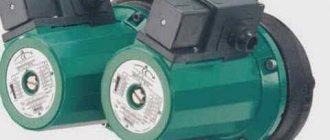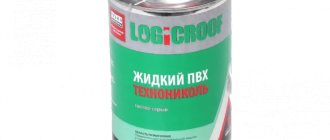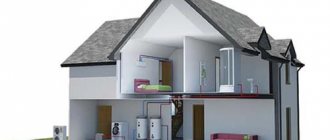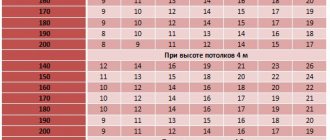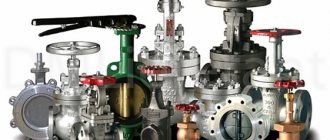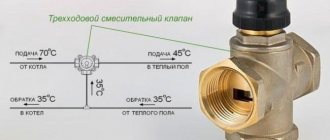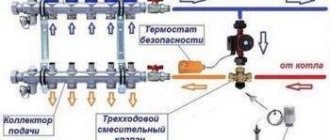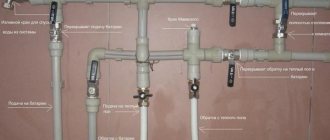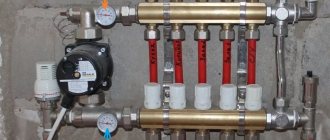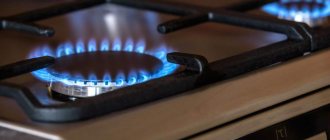Areas of application
The three-way valve, the operating principle of which was discussed above, has a fairly wide range of applications.
Thus, its varieties, such as an electromagnetic device or a device with a thermal head, are often found in modern pipelines, where it is necessary to adjust the proportions when mixing two separated liquid streams, but without reducing power or volume. As for household use, the most popular here is considered to be a thermostatic mixing device, with which, as noted above, you can regulate the temperature of the working fluid. This liquid can be supplied both to the “warm floor” pipeline and to heating radiators. And if the valve also has automatic control, then you can control the temperature in your home without any problems!
Note! The use of a three-way valve in a heating system to balance temperature changes is extremely beneficial not only in terms of comfort and convenience, but also in terms of cost savings. The fact is that by regulating the temperature of the liquid at the “return” of the heating device, you can significantly reduce the volume of fuel consumed, and this will have a positive effect on the efficiency of the system itself
In some systems, a valve is simply necessary. For example, in a “warm floor” system, this device prevents overheating of the floor covering above a given comfort level, thereby relieving users of unpleasant sensations
The fact is that by regulating the temperature of the liquid at the “return” of the heating device, you can significantly reduce the volume of fuel consumed, and this will have a positive effect on the efficiency of the system itself. In some systems, a valve is simply necessary. For example, in a “warm floor” system, this device prevents overheating of the floor covering above a given comfort level, thereby relieving users of unpleasant sensations.
Regulating devices of this kind are also used in water supply systems in order to obtain a permanent flow at the required temperature. The simplest example is an ordinary mixer, in which you can make water hotter/cooler by opening/closing a cold tap.
Safety valve for boiler
Previously, we described how to select and connect a safety valve for a boiler, talked about its areas of application and internal structure. In addition to this article, we recommend that you read: all the details here
Valve design and purpose
A standard three-way valve consists of the following elements:
- three pipes connected to the heating system circuits;
- a mixing chamber, inside of which the temperature regime is adjusted;
- a rod that blocks the flow of water from any pipe;
- a thermostat that sets the rod in motion depending on the parameters specified by the user.
Sectional view of a three-way valve
Devices of this type can be used:
- in heating systems of residential and industrial premises for mixing or dividing the coolant flow;
- in systems there is a warm floor (by analogy with the previous paragraph);
- in the hot water supply system to eliminate the possibility of increasing the water temperature.
Operating principle and types of valve actuators
The product is produced in different configurations and with different drives, but the principle of operation of the three-way valve remains unchanged: mix two flows with different temperatures into one, the temperature of which is specified by the user or required by the scheme. The liquid inside the valve flows from one pipe to another until its temperature changes and reaches the set value. Then the drive gradually opens the flow from the third pipe, keeping the temperature of the leaving water within the set value. On this basis, such a valve is called a three-way valve.
Operating principle of three-way valve
Any three-way mixing valve has two inlets and one outlet. Flow distribution is carried out using a drive, which comes in several types:
- The thermostatic drive (thermostat) is one of the most popular; it works due to the thermal expansion of the sensing element, as a result of which pressure is placed on the valve stem and the liquid begins to mix.
- A widely used type of drive that is installed in a three-way changeover valve is electric, operating from a signal from the control unit.
- The valve can be controlled by pressing the stem using a thermostatic head drive. It reacts to the air temperature, which it determines itself or using a remote sensor and a capillary tube. The drive is most often used in underfloor heating systems.
Stationary solid fuel boilers cannot be directly included in the heating system. One of the reasons is to prevent cold water from entering the boiler jacket until it has warmed up. Otherwise, condensation is released on the walls of the firebox, which, mixing with ash, forms a durable layer of soot. It interferes with free heat exchange, reducing the efficiency of the installation, and it is very difficult to clean off carbon deposits. The second reason is that cast iron fireboxes need to be protected from temperature changes in the event of an unexpected pump stop due to a power outage, and then its restart. The task is to prevent cold water from entering the hot boiler, which is why a three-way valve is needed. He will force the coolant to circulate in a small circle until it warms up, and only then will he begin to mix in cold water.
Advantages and disadvantages
Advantages of three-way mixing valves:
- Simple design.
- Stable regulation.
- Reliability.
- Tightness.
- Sufficient adjustment accuracy (maximum accuracy – up to 1°C).
- Durability.
- Relatively compact dimensions.
The biggest advantage of using three-way valves is that the pipelines and, accordingly, the screed and floor covering do not overheat, which prevents premature failure of the screed and coating.
Flaws:
- The hydraulic resistance of three-way designs is higher than that of a conventional two-way valve.
- The design of the body and spool allows for the presence of stagnant zones - periodically you will have to dismantle the device and clean it of scale, debris, and organic impurities.
- Insufficient accuracy of room temperature control. The control valve quite accurately regulates only the temperature of the outlet coolant, and the temperature of the heated room - approximately.
To ensure a comfortable level of heating, you will have to select the ratio of the temperature of the outlet flow and the temperature in the room “at random”. Unfortunately, the underfloor heating pipelines are much larger than the radiator, and it is impossible to ensure accurate adjustment. The situation is further complicated by the inertia of the heated floor - a 100-mm cement screed warms up very slowly.
But if you are stoic about slowly heating or cooling a room, then a valve with mechanical adjustment is quite suitable for use in the heating system of a private house or apartment.
Three-way valve control limits
Let's calculate the control range of a three-way control valve. To do this, consider an air cooler battery, the connection of which is made with reversible heat removal. It is known that at a nominal flow rate Qv the hydraulic resistance will be ΔРbat = 5 m of water. st (Fig. 98.49).
In the first diagram of Fig. 98.49 we see a valve VЗV with a resistance ΔРvзv 10 times less than the resistance of the battery. The valve serves to change the flow through the battery. Its control range will be: ΔРvзv/(ΔРvзv+ ΔРbat)=0.5/(0.5+5)=0.09.
In the second diagram, the valve resistance ΔРvзv will be 10 times greater than the battery resistance, since the valve serves to change the water flow through the battery, the control range of which is: ΔРvзv/(ΔРvзv+ ΔРbat)=50/(50+5)=0.91.
Application and connection diagrams
To prevent cold coolant from entering the jacket of the solid fuel boiler when it is warming up, a connection diagram for a three-way valve with a primary circulation circuit is used:
Three way valve connection
A three-way valve cuts off cold water from the return pipeline so that condensation does not appear on the internal walls of the solid fuel boiler chamber, which can significantly reduce the service life of the unit. The coolant circulates in the primary circuit until it heats up to the temperature set on the valve thermoelement, usually 40-50 ⁰C. Once this temperature is reached, the thermostat acts on the rod, gradually opening the flow of cold water from the heating system. For hydraulic adjustment of the entire system, a balancing valve is embedded in the small circuit. For the boiler piping circuit to work correctly, the circulation pump must be installed after the three-way valve, and not in front of it; this is a very common mistake.
A continuation of this scheme could be the organization of a secondary circulation circuit, which involves its own pump and three-way valve for heating. The connection is carried out according to the following scheme:
Three way changeover valve
In the secondary circuit, hot water from the boiler is added to the heating system as needed, and the pump ensures circulation in this circuit. The three-way valve and pump are controlled by a controller, which receives data on coolant parameters from sensors. Water is taken for the boiler between two circuits, where the coolant has a maximum temperature; the three-way valve is connected to the boiler in the primary circuit, as shown in the previous diagram.
Many manufacturers of boiler equipment install an additional circuit in their heating units to provide DHW consumers. In order to maintain the parameters of hot water supplied to the house, equipment for switching the main heat exchanger to the DHW circuit and back is installed inside the boiler. The operating principle and design of the three-way gas boiler valve involved in this process is not much different from the products described above. There is a slight difference in the design, which is a straight manifold; an element moves inside it, blocking the side pipes. The rod rotates using a servo drive upon command from the built-in boiler control unit.
Another area of application is the control of underfloor heating; for this, a three-way valve with a thermal head and a remote temperature sensor is usually used. The general scheme looks like this:
Three-way mixing valve with thermal head
The circuit ensures that all rooms are supplied with coolant at the same temperature. A three-way valve is needed to prevent overheating, since underfloor heating systems do not require the same hot water that comes from the boiler system. The pump creates circulation in all circuits, and the valve mixes hot coolant into the supply manifold as needed. Such a mixing unit is one of the simplest connection options; the circuit becomes more complicated when it is necessary to adjust the temperature in each room separately.
Areas of application
Modern valves are in wide demand and are actively used in various areas of human activity. They are often installed in modern heating mains, which require constant adjustment of proportions when mixing different coolant flows. For such purposes, it is customary to use electromagnetic devices or models with a thermal head.
As for domestic use, in this case it is enough to purchase a thermostatic mixing device that will allow you to regulate the temperature of the coolant. It is supplied both to the underfloor heating piping system and to heating radiators. And if the household device is equipped with automatic control, then changing the temperature in the room will be much easier.
The use of a three-way valve in a heating system is profitable and economical
It should be noted that using a tee in a heating system to balance possible temperature surges is not only beneficial, but also economical. The device allows you to reduce the volume of fuel consumed several times, while the final efficiency indicators of the system will increase noticeably. In some rooms, the presence of such a device is simply necessary. For example, if a heated floor is installed in the house, then the device will prevent excessive heating of the floor covering.
Regulation range
To better assimilate this material, first consider a rheostat with a resistance of 10 Ohms, in series with which a 100 W light bulb is installed.
It is known that power is calculated according to the formula P=U2/R, which means P=100x100/100=100 Ohm. We connect the circuit (Fig. 98.46) to a voltage of 100 V. If the rheostat lever is in the extreme right position, then the resistance will be zero and the voltage on the lamp will reach the nominal 100 V.
Now let’s move the rheostat lever to the extreme left position (position 2), after which, together with the lamp, there will be a rheostat with a resistance of 10 Ohms. The network resistance will be equal to Rt=10+100=110 Ohm. The current strength will be determined as follows: I=U/Rt=100/110=0.91 A.
The voltage at the lamp terminals will be: UL=RxI=100x0.91==91 V (instead of 100V). Lamp power: P=U2/R=91x91/100=83 W (instead of 100 W). Accordingly, the lamp will shine weaker.
It follows from this that the rheostat is designed to regulate the degree of incandescence of the lamp. At the same time, the control of the degree of illumination by the rheostat is within 17%. The rheostat is not designed to change illumination over a wide range.
How to choose a valve for a heated floor
The popularity of water floors, which are increasingly used for heating private houses and country cottages, has given impetus to the emergence of a huge selection of models on the market. But here the question arises: which three-way valve to install on the heated floor, which manufacturer to choose. After all, the abundance of goods makes shopping difficult. When selecting a device, experts recommend deciding in advance what type of device is needed—two- or three-way. Then select the manufacturer:
- Valtec. The company presents Russian-Italian products on the market. Their main advantage is a budget price with excellent physical and technical qualities. The manufacturer provides a 7-year warranty on the purchased three-way valve for heated floors with a thermostat. The products are supplied with quality certificates, technical data sheets, installation recommendations and a warranty card.
- Esbe. The Swedish company offers high-quality underfloor heating taps made from innovative materials. The devices are maximally resistant to operating conditions, reliable and visually attractive. When purchasing Swedish devices, it is recommended to carefully consider the technical characteristics of the equipment. There is a small chance that the parameters will not match. The cranes are supplied with certificates and warranty cards, the service life is over 5 years.
Honeywell. The thermostatic mixing valve for underfloor heating from the American company Honeywell is distinguished by its high technology and excellent design. The main advantages of its products are practicality and simplified installation. The design is designed in such a way as to make installation of the equipment as easy as possible. Errors are excluded. The company is proud of its innovative developments, which it implements in the manufacture of devices. This makes them more efficient and reliable, but also more expensive.
From the listed manufacturers, consumers buy time-tested three-way valves for underfloor heating. But you shouldn’t rely only on the quality of the equipment, because even the most stable and reliable device will not be able to protect the system if it is installed incorrectly. In this case, the choice should also be based on the throughput of the unit. This parameter should be clarified in the technical documentation for the equipment. When designing a system for auxiliary heating of air masses from below the room, its power, throughput, heat loss, etc. must be calculated.
Types of three-way valves and features of their operation
First of all, three-way thermal valves are classified according to their purpose into separation and mixing:
The mixing valve has 2 directions to supply coolant of different temperatures (hot and cold), and 1 direction removes the already mixed liquid flow. Setting the required temperature parameters is carried out by adjusting the temperature and proportions of the supplied flows.
The thermal distribution valve has 1 pipe supplying coolant, and 2 others divide it among themselves and distribute it in different directions.
According to the control method, three-way thermal valves are autonomous, manual, thermostatic and electric. The last two, as a rule, work automatically.
Simple stand-alone models are equipped with a thermostatic element installed inside the housing with the outlet coolant temperature already set at the factory. This value remains constant throughout the entire service life.
| Self-contained three-way mixing valve | |
| pros | Minuses |
| Low price | The need to select a valve for the return temperature of the heat generator |
| Coolant temperature control | The factory-set temperature setting cannot be changed. |
For manual control, the rod is equipped with a valve or rotary knob and a control panel with marks, according to which the thermal regime is regulated.
| Manual 3-way mixing valve | |
| pros | Minuses |
| Relatively low price | The need for constant human control, as a consequence, the protracted nature of the response to changes in environmental conditions |
| Coolant temperature control | |
| Possibility of changing temperature conditions during operation | Uneven heating of the heating circuit |
A three-way thermostatic valve with a thermostat is equipped with a thermostat filled with a liquid or gaseous medium that responds to the slightest fluctuations in coolant temperature.
As soon as the coolant heats up to the set temperature, due to the expansion of the reagent, the piston thermal valve system is automatically activated and the pipe with hot flows is closed.
Three-way valves with thermostat can be mechanical or electronic. The advantage of mechanical models is their absolute autonomy. Electronic ones require connection to a power supply or are powered by batteries.
However, this drawback is mitigated by the complete automation of the process, ease of setup and expanded functionality - automatic change of temperature according to the time of day, day of the week, etc.
| Three-way mixing valve with thermostat | |
| pros | Minuses |
| Automatic control of coolant temperature | High price |
| Ability to change temperature conditions | Extremely precise settings are required; errors in the set parameters lead to a small error in the operation of the system |
| Uniform heating of the heating circuit |
Three-way thermal valves with electric drive are controlled by an electronic control unit operating on a servo drive. If the temperature of the coolant goes beyond the set values, it is detected by a thermostat installed in the module, which signals this to the controller. It transmits a command to the drive, regulating the flow of cold or hot coolant in the system.
In this case, none of the pipes, as a rule, is completely blocked, but only the volume of supplied cooled and hot coolant is regulated.
| Electrically actuated three-way mixing valve | |
| pros | Minuses |
| Automatic control of coolant temperature | High price |
| Possibility of changing temperature conditions | Increased energy consumption |
| Precise temperature control of the coolant flow | Increased coolant consumption |
| Uniform heating of the heating circuit |
Features of automatic devices
To ensure efficient operation of the thermomixing valve, the process of creating a mixed fluid flow must be continuously monitored. It is better if this is done automatically.
Automatically controlled devices are regulated by electrical or pneumatic components.
- Electric drives are relatively inexpensive and easy to connect. This largely explains their popularity and wide distribution. On the other hand, their dependence on power supply and the need for periodic maintenance make them not reliable enough.
- Pneumatic actuators are more expensive, and their connection procedure is more complicated. However, these shortcomings are compensated by a long service life and complete autonomy.
We recommend that you read: Shut-off valves and their use in pipeline systems
Brief overview of three-way valve manufacturers
There are many companies that produce such equipment, but three of them are the most popular - Esbe, Navien and Danfoss. It is these brands that we will talk about today. Along the way, we will also learn about the opinions of network users who have installed similar faucets in apartments or private houses.
Three-way valves "Esbe" with electric drive
Thermostatic valve "Esbe" - time-tested reliability.
The model "ESBE VRG131" is interesting. Let's take a closer look at it. On store shelves it is found only with manual adjustment, but no one bothers to install an automatic one instead of the handle.
Technical characteristics of "ESBE VRG131" in comparison with "ESBE VTA522"
| Model | Working pressure, bar | Max t, °С | Thread diameter, inch | Throughput, m3/h |
| ESBE VRG131 | 10 | 110 | 3/4 | 6.3 |
| ESBE VTA522 | 10 | 95 | 1 | 3.2 |
"Navien": Korean-assembled equipment
It so happens that Korean goods are always of high quality. This statement applies to any technology as long as it is not counterfeited. Those who respect their reputation monitor all technological processes. And the low cost is due precisely to the fact that production in China is cheaper than in other countries.
Three-way valve "Navien" comes from Korea
The cost of Navien three-way valves is lower than that of the previous brand, but this does not mean that they are worse. Psychology plays a role here. The manufacturing company is less known, which means the markup on the brand is lower.
Danfoss three-way valves and their features
Given the high quality of the equipment produced, experts warn the consumer that their devices cannot be lubricated with mineral or semi-synthetic oils. Only synthetics are allowed to be used. There are also high demands on the quality of the coolant. In case of violation of operating conditions, the manufacturer declines all responsibility.
Equipment for heating systems,
For example, let's look at models produced by Danfoss - RTR-N 15 UK and RA-NCX.
| Model | Working pressure, bar | Max t, °С | Thread diameter, inch | Throughput, m3/h |
| RTR-N 15 UK | 10 | 90 | 1/2 | 0.9 |
| RA-NCX | 10 | 100 | 1/2 | 1 |
As you can see, the devices are almost identical, but the cost of “RTR-N 15 UK” is 1800 rubles, and the price of “RA-NCX” is 2200 rubles (prices are indicated as of January 2021).
However, there are plenty of other worthy manufacturers on Russian shelves. Let's try to summarize the information about their models in tabular form.
It happens that the thermostat comes complete with a heating radiator when purchasing
Selecting an ESBE mixing valve
ESBE 3-way or 4-way mixing valves, sizes DN 15-150 for heating and refrigeration systems in construction. ESBE three-way valves are typically used as mixing valves, but can be used as switching or separating valves. Four-way valves are used when a high temperature of the coolant returning to the boiler is required.Application
1) Management (quality) of radiator, floor and other heating systems, as well as refrigeration systems.
2) Switching or splitting the flow (only for 3-way valves). It is necessary to ensure that the nominal pressure, pressure drop and flow are within acceptable limits. This information is given for each valve.
How to choose a rotary mixing valve
If you require a high return water temperature (usually for solid fuel boilers), then it is advisable to choose a 4-way valve. In all other cases, preference is given to 3-way valves.
In systems with two heat sources or a storage tank, the BIV series valves will help prioritize the use of a low-cost heat source while maintaining good temperature separation in the storage tank.
How does a 3 way valve work?
The required temperature in the system is ensured by proportionally adding colder coolant to the hotter coolant flow from the boiler. How a 4-way valve works This valve has a double mixing function, that is, the hotter coolant is mixed with the colder coolant entering the boiler. This allows you to increase the temperature of the coolant returning to the boiler and reduce the risk of low-temperature corrosion, and thereby extend the operating time of the boiler.
Mixing Valve Sizing
Each mixing valve has a Kvs characteristic (flow capacity m3/h at 1 bar pressure loss). The Kvs parameter helps determine which valve is needed for your system. Kvs can be determined from the graph (Fig. 1).
For radiator heating systems it is usually used _t = 20°C, and for underfloor heating systems _t = 5°C. The pressure loss range should be between 3-15 kPa. If two valves fall within this range, usually the valve with the lower Kvs is selected.
Materials
Valves of the VRG series are made of a special brass alloy, which allows them to be used for sanitary hot water supply systems. All other ESBE valves can only be used in systems with water that does not contain dissolved oxygen.
Selecting a mixing valve for heating systems (radiator or floor)
We start from the thermal power of the boiler in kW (for example, 25 kW) and move vertically to the selected temperature regime ^t (for example, 15°C). Next, we move horizontally to the shaded area (pressure drop range 3-15 kPa) and select a lower value of the Kvs coefficient (for example, 4.0). In this case, we select the desired type of valve with a coefficient Kvs = 4.0
You can get additional information about choosing ESBE valves or place an order by contacting our office: tel.: (495) 921-65-00, E-mail
Criterias of choice
Three-way valve for solid fuel boiler
Before choosing a three-way valve for the boiler, you need to find out the operating parameters of the coolant, its flow rate and piping diagram. The temperature and flow rate of the coolant are determined from the design documentation; if it is missing, then the recommended water temperature in the return pipeline can be found in the passport for the solid fuel boiler. As a rule, it is 45-50 ⁰С. The coolant flow rate needs to be known in order to select a three-way valve based on its capacity. If there is no data, you just need to use the formula:
G = 3600Q / s (∆t), where:
- G – water consumption by mass, kg/h;
- Q – thermal power of the heating system;
- с – specific heat capacity of water, equal to 4.187 kJ / (kg ⁰С);
- ∆t – temperature difference in the supply and return pipelines.
Considering that for water the values of mass and volume are identical, the flow rate can be expressed both in kg/h and in dm3/h. Having calculated the flow rate, compare its value with the capacity of the crane indicated in the passport.
It is necessary to select a product by drive type depending on the wiring diagram of the solid fuel installation. The simplest connection diagram uses a three-way thermostatic valve for the boiler:
Here we show the connection of a heating installation with a heat accumulator, the water in which begins to warm up only after the solid fuel boiler has heated the water circulating in a small circle (through pipes No. 3 and 1) to the set temperature. When the coolant heats up, the three-way valve, set to one of three possible temperatures, will begin to open the flow of cold water from pipe No. 2. Then hot water will flow into the heat accumulator tank, replacing the outgoing cold water.
A more complex piping scheme involves the use of a solid fuel boiler with a three-way valve controlled by an external controller:
Diagram of using a solid fuel boiler with a three-way valve
Mixing taps with two types of drives are used here, operating in two coolant circulation circuits. The first one, standing near the heat source, is thermostatic and works according to the principle discussed above. The second has an electric drive, controlled by a controller depending on sensor signals. Here, the operation of the three-way valve is aimed at maintaining the required temperature of the coolant in the heating system circuit. An electrically driven device can also be used in the primary circuit if two or more different boiler units are operating in the boiler room under the control of one controller.
Another criterion by which you should choose a three-way valve for solid fuel boilers is the range of set temperatures. Here we are talking about products with a thermostatic drive, which can be used both in boiler piping and in underfloor heating or hot water systems. Manufacturers offer taps with different adjustment ranges depending on the purpose of the product, for example, from 20 to 43 ⁰С, from 35 to 60 ⁰С and so on
You need to pay attention to this when purchasing; in this example, for connecting to a solid fuel boiler, the second option is preferable
Before installing the trim, it will be useful to know how to check the three-way valve that you recently purchased. It is not difficult to test a new product: you just need to set the minimum temperature from the adjustable range and pour hot water into pipe No. 3 (see Figure). After some time, a functional tap will turn it off. You can check the valve in an already installed system by measuring the temperature of the water in the return pipeline at the inlet to the solid fuel boiler. Its value must correspond to that set on the thermostat.
Control valve calculation method
Two-way control valves in engineering systems have a lot of applications, the most common of which is their use in conjunction with a controller and temperature sensors, as a regulator of heat consumption in heating, ventilation and hot water supply systems.
Regardless of the task at hand, the calculation of a control valve comes down to determining its capacity at which a given excess pressure will be throttled at a given flow rate. In addition to matching the flow rate, the selected control valve must be checked for the possibility of cavitation and noise generation due to the high speed of water flow through it.
A control valve is necessary, first of all, for regulation, therefore it must be selected in such a way as to bring the dependence of the controlled value on the stroke of the rod as close as possible to linear, while taking into account the importance of such parameters as the flow characteristic of the valve and the authority of the control valve.
Valve with thermostat function
This type of valve regulates the intensity of both water flows - hot and cold. Thus, the required temperature value is achieved and maintained at a given level. Flows are regulated using a thermostat, which responds to liquid indicators and helps maintain stable temperature values.
Such a three-way valve for heated floors can also be used to install a hot water supply pipeline. Thanks to the presence of automatic water temperature control, the consumer will be protected from scalding when he opens the tap. The mechanism of action of the valve involves automatically shutting off the valve with hot water if there is also no cold water. In addition, temperature-sensitive sensors are installed inside the valve that detect the temperature of the incoming fluid flows and automatically contract or expand the holes until the optimal temperature is reached.
Selection of flow characteristics of a control valve
The flow characteristic of a control valve displays the dependence of the change in relative flow through the valve on the change in the relative stroke of the control valve rod at a constant pressure drop across it.
Control valves with a linear flow characteristic are recommended to be used for regulating processes in which the change in the controlled variable linearly depends on the flow rate; they can be used as control valves for flow regulators and for regulating the temperature of the mixture in heating points of heating systems with dependent connection to the heating network.
Control valves with a logarithmic (equal percentage) flow characteristic are recommended for use in systems in which the change in the controlled variable nonlinearly depends on the flow rate and in systems with low authority of the control valve. Regulators with an equal percentage flow characteristic are excellent for regulating the heat transfer of heat exchangers of independent heating systems and hot water supply systems with high-speed heat exchangers. When the control valve authority is 0.1 - 0.3, the logarithmic characteristic is distorted so much that regulation occurs almost according to a linear law (linear characteristic).
The main task of selecting a control valve is to create a linear relationship between the control action and the change in the controlled variable, therefore, when choosing a flow characteristic, its distortion should be taken into account due to the difference in valve authority from unity.
